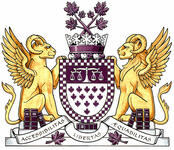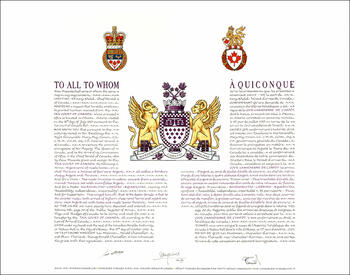The contents of this Register are intended for research purposes only. The heraldic emblems found in the Register may not be reproduced in any form or in any media without the written consent of the Canadian Heraldic Authority and/or the recipient.
Ottawa, Ontario
Grant of Arms and Supporters
October 15, 2021
Vol. VIII, p. 30
Arms of the Tax Court of CanadaBlazonArgent semé of maple leaves, on a chief Purpure a balance of four pans Argent, all within a bordure chequy Argent and Purpure; SymbolismPurple, the emblematic colour of the Tax Court of Canada, adorns the sashes of its judges’ robes. The chequered pattern alludes to the Court’s predecessor, the Exchequer Court of Canada, whose name derives from the chequered cloth used in medieval times to record monies demanded and received. The double scale of justice represents the two legal traditions of Canada—common law and civil law—as well as fairness in the judicial process. The maple leaves symbolize Canada’s thirteen provinces and territories, and by extension the Court’s accessibility, the fact that it is an itinerant court and that it reaches every part of the country. |
CrestBlazonTwo maple branches in saltire issuant from a coronet rimmed Purpure set with snowflakes Argent; SymbolismThe two maple tree branches represent Canada and its Constitution, described by Lord Sankey in Edwards v. Canada as a living tree able to adapt to ever-changing times. The crown, a symbol of authority, is composed of snowflakes, recalling the Queen’s Snowflake Diadem, a reference to Canada being a northern realm. |
MottoBlazonACCESSIBILITAS • LIBERTAS • ÆQUABILITAS; SymbolismThese Latin words mean “Accessibility, independence, impartiality.” They underline the ability of the Tax Court of Canada to travel across the country to hear cases directly from taxpayers, in addition to providing an accessible appeal process with straightforward rules and procedures. The words also recall the principle of fairness and equality of rights, and they emphasize the principle of judicial independence. |
SupportersBlazonTwo winged lions Or, that to the dexter female, that to the sinister male, both attired of bighorn sheep rams’ horns and sejant on stone steps Argent set with books and maple leaves Purpure; SymbolismThese unique heraldic creatures represent the reach of the Tax Court to all parts of Canada by land and air. They combine the majesty of the lion, king of land animals, and the swiftness of the eagle, king of birds, thus merging the strength, vigilance and insight of both. The ram’s horns symbolize determination and leadership. The creatures, one female and one male, symbolize gender equality. The books embody knowledge, wisdom and the fact-driven decisions that the Court renders. |
Additional InformationCreator(s)Original concept of the Tax Court of Canada, assisted by the heralds of the Canadian Heraldic Authority. PainterDavid Farrar CalligrapherDoris Wionzek Recipient TypeCivil Institution
|



